Family : Muraenidae

Text © Giuseppe Mazza

English translation by Mario Beltramini
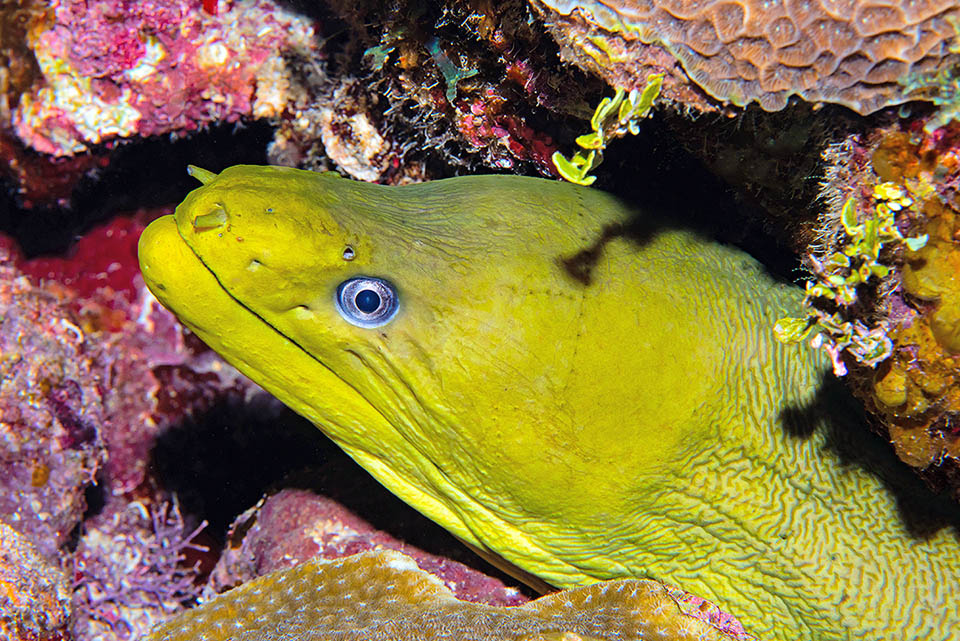
Even 2,5 m long and weighing almost 30 kg the Green moray (Gymnothorax funebris) has very few wild enemies in the Caribbean. Moreover it boasts a very vast area, from Florida and the Bermuda Islands to Brazil and then, carried by the Gulf Stream, has also reached the African coasts of Senegal on the other side of the Atlantic © Brian Cole
The Green moray (Gymnothorax funebris Ranzani, 1839), belongs to the class of the Actinopterygii, the ray-finned fishes, to the order of the Anguilliformes and to the family of the Muraenidae.
The name of the genus Gymnothorax comes from the Greek “gymnos”, naked and from the Latin “thorax”, thorax, with reference to the fact that unlike eels the thorax has no pectoral fins and therefore is naked. The specific name funebris, funereal in Latin, refers to the uniform and dull colour with greenish shades of the species.
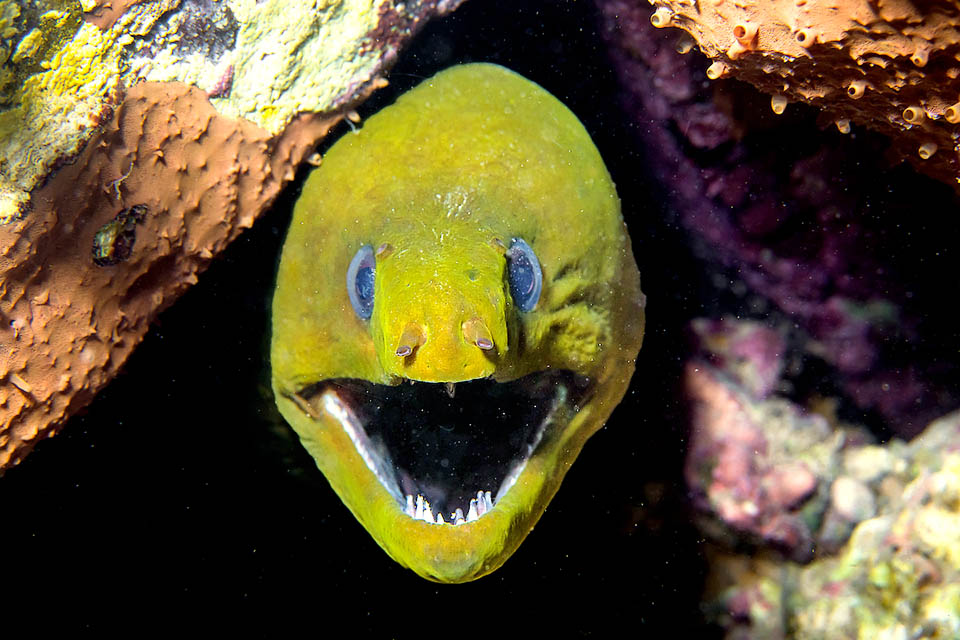
The eyesight is modest but anyway hunts the night guided by an exceptional sense of smell. Here are well visible the tubular nostrils and the row of teeth on the lower jaw. The push is given by a second particular jaw placed inside the neck and so invisible, called pharyngeal, present in morays that eat on bulky preys © Allison & Carlos Estape
Zoogeography
The Green moray is present along the American Atlantic tropical coasts from Florida and Bahamas up to Brazil, but also in the Cape Verde Islands and along the coasts of Senegal where it has arrived carried by the Gulf Stream.
Nobody knows how, but it has been reported also in California in the Sea of Cortez.
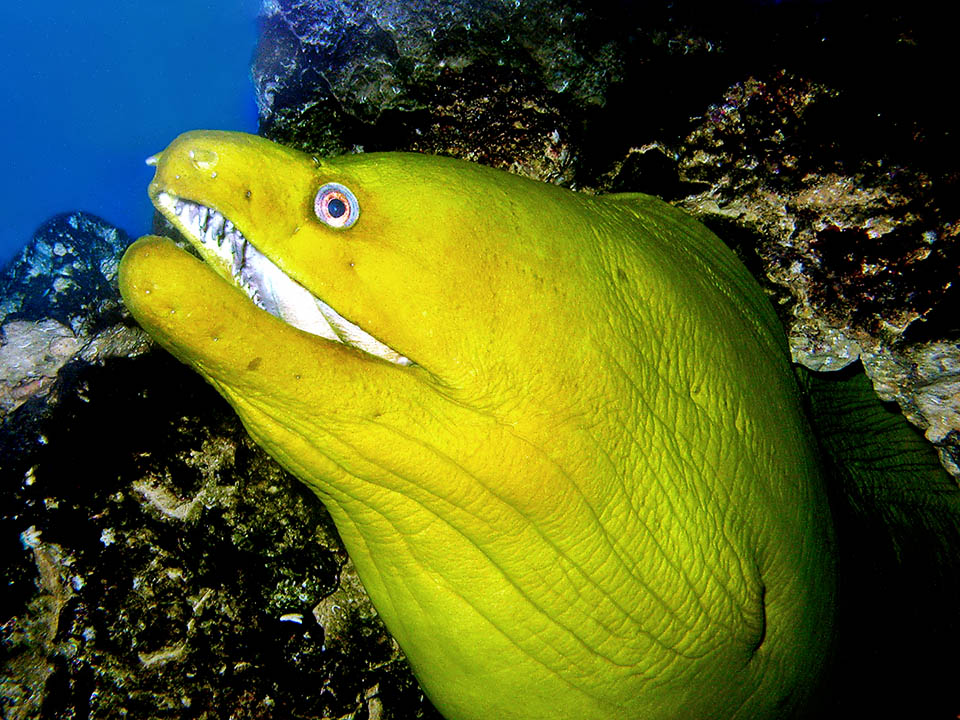
The upper one has two rows of teeth, the first near the vomerine to hold the preys, and the second below, at throat level, to bring ahead the bites to the esophagus © Giuseppe Mazza
Ecology-Habitat
Gymnothorax funebris lives among the rocks and in the crevices of the coral formations, usually from 3 to 30-50 m of depth, but may be found also in the mangrove formations and on the sandy seabeds.
Morphophysiology
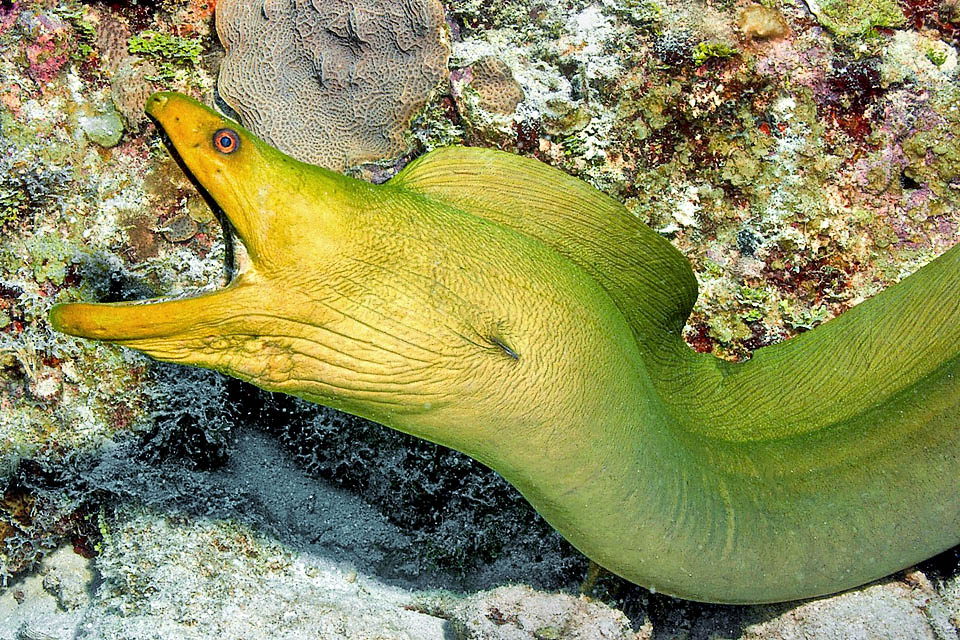
The branchial orifices are reduced to two simple holes sited at the end of the head on the mouth extension. From these doesn’t enter the water to oxygenate the gills, but gets out, because the morays take it through the mouth. And even if this had possibly other intentions, usually they open and close continuously the jaws for breathing © Allison & Carlos Estape
Even if usually just exceeds the metre and a half, have been fished 2,5 m and 29 kg specimens.
Like in all Anguilliformes the pelvic fins are absent and the dorsal, caudal and anal fins have merged to form one single long cutaneous crest used for a wavy swimming movement. Gymnothorax funebris does not have a very good eyesight but has two show tubular nostrils for an extraordinary sense of smell that allows them to detect the preys in depth also even in the dark of the night.
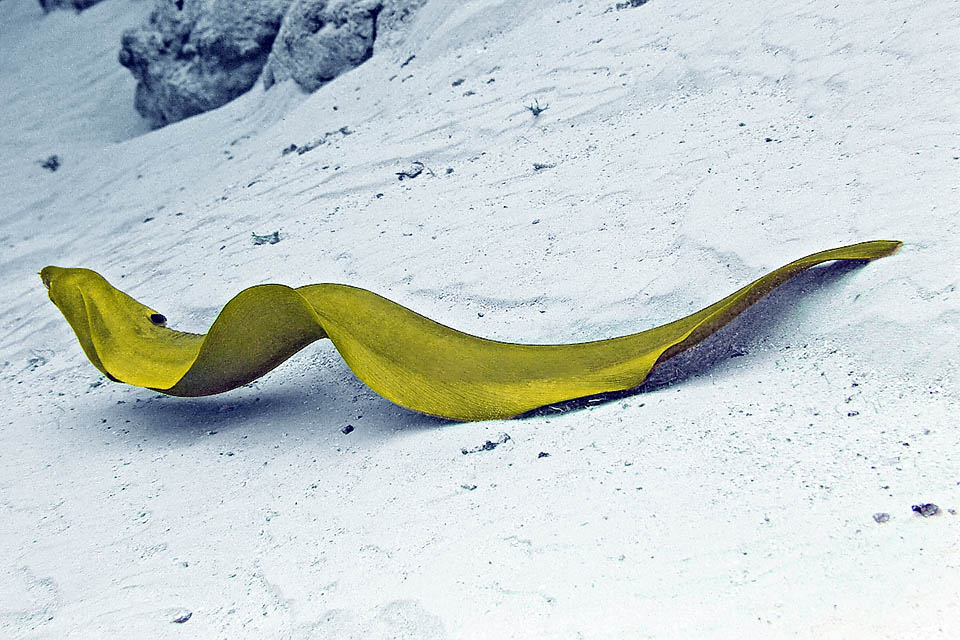
The Green moray doesn’t have pectoral fins and the others are merged in one unique long skin crest for a wavy swimming and is not rare to find it active during the day © Allison & Carlos Estape
The branchial orifices are reduced to two simple holes, situated on the end of the head, on the extension of the mouth. The water to oxygenate the gills does not enter through these, but gets out, because the morays take air through the mouth they open and shut continuously, hence not for threatening but for breathing.
This doesn’t mean that the hooked teeth are well visible. In adults we note at once a row on the lower jaw, whilst the upper one has two rows of teeth, plus another one located in the bottom and teeth, called vomerine, on the palate to hold the preys.
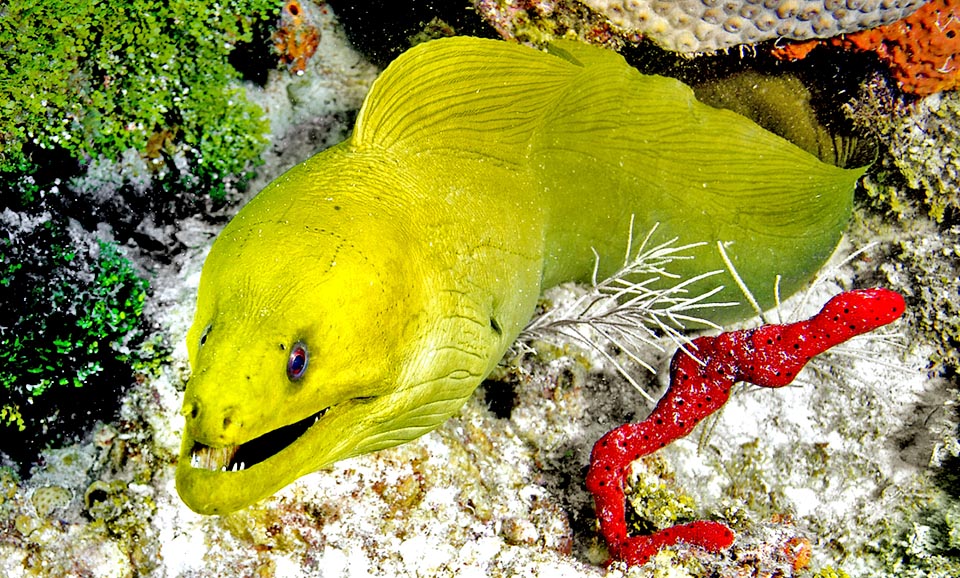
Its true livery is brown and the greenish yellow colour comes from the mucus emitted to protect from bacteria and parasites © Allison & Carlos Estape
The skin, scaleless, is actually brown and the greenish livery with yellow shades originated from the colour of the mucus secreted to protect against bacteria and parasites.
Some specimens, especially the juveniles, can be brownish or even almost black.
For eliminating the parasites of the skin concur some shrimps and Caribbean cleaning fishes such as the Neon goby (Elacatinus oceanops).
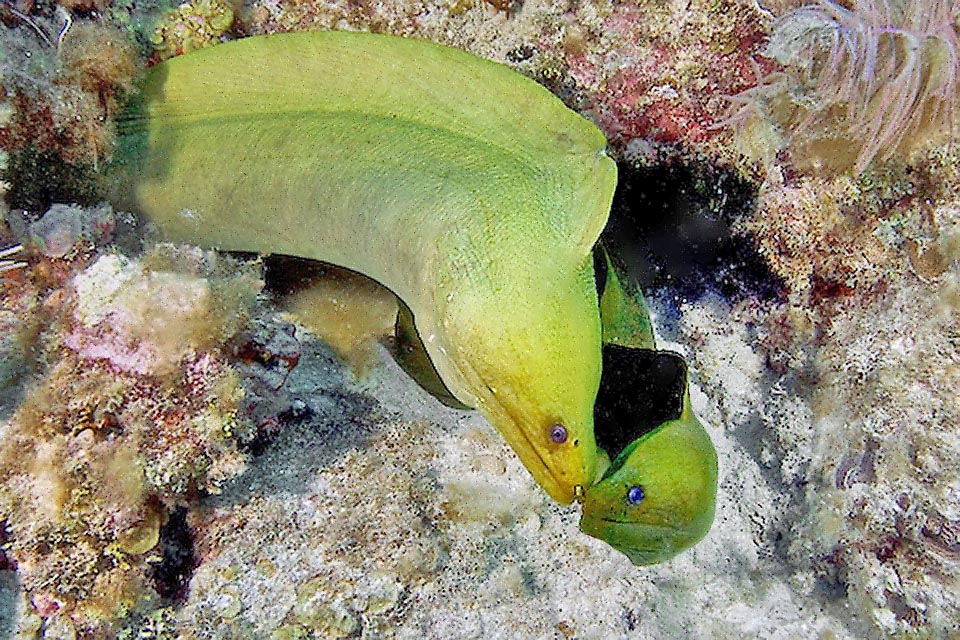
Lives solitary but can shares den with sharks or morays of other species. But here we see two Green morays. Is it love? Difficult to say. Little is known about reproduction © Allison & Carlos Estape
Ethology-Reproductive Biology
Gymnothorax funebris gets out at sunset looking for fishes, cuttlefish and various species of crustaceans. When the prey is too big to swallow whole, it wraps the same in its coils like a snake and devours it in bites.
It can also go hunting together with a grouper like Cephalopholis cruentata and share the loot, because four eyes see better than two.
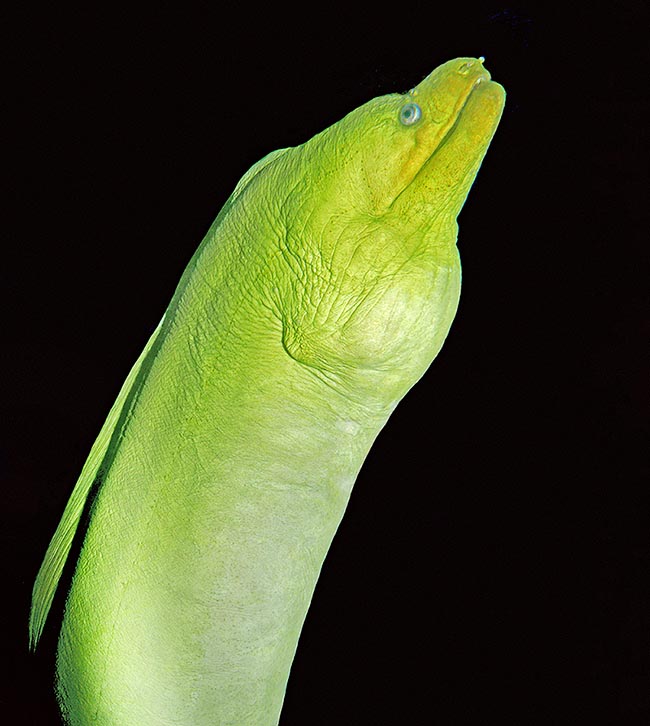
This goes hunting alone, but not always. Like other morays it can for instance predate together with a grouper © Giuseppe Mazza
Usually also these big morays do not attack man and at the sight of a diver they let themselves be approached without fear because in nature, seeing the size and their hidden life, they practically do not have predators.
Consequently, after having observed and sniffed them, they retreat peacefully, seeing that they are neither prey nor predators.
But one must not exaggerate and especially they should not be disturbed when they peek at the entrance to their den, as they may feel threatened and thus vigorously defend their home.
Like the snakes, they put their head back and strike forcefully from top to bottom.
There is no poison, but apart from pain and scratches, the wounds are actual injections of pathogens that are decomposing between the teeth.
For the unfortunate, when they furiously attack, there is also the risk of losing the snorkel and of dying by drowning.
After all, it doesn’t even make sense to harpoon them for table, due to the presence in their flesh of the ciguatoxin, the poison produced by a dinoflagellate microalga, Gambierdiscus toxicus.
The numerous herbivorous fishes, eating it, store it in their tissues, and the carnivorous fishes, preying upon them, concentrate it day after day into their body. It is obvious that a moray weighing more than 20 kg that has assimilated it for years is poisoned and may cause in the unwary a serious food poisoning, without antidotes, known as ciguatera.
It manifests itself with alterations of the sensitivity, itches, difficulty in swallowing, involuntary muscle contractions, convulsions and altered perception, sometimes opposite, of heat and cold that may last even months.
The reproduction of the Green moray is shrouded in mystery. What is sure is that there are no parental cares.
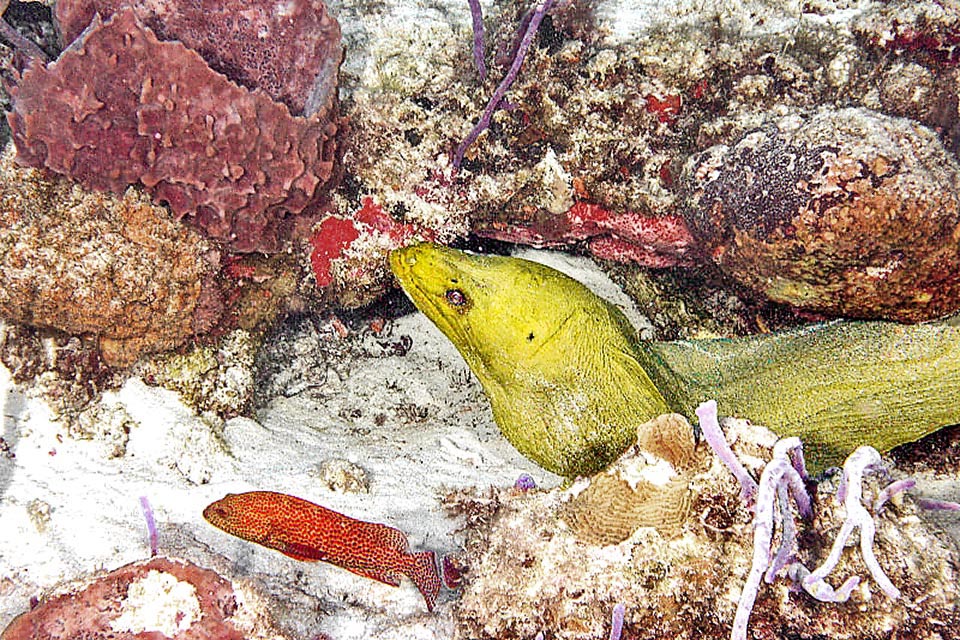
Here it is with Cephalopholis cruentata. Benefit is mutual because four eyes see better than two and also the sense of smell of Gymnothorax funebris has its importance © Kevin Bryant
It seems that there are reproductive migrations towards certain sites they reach guided by smell.
The females spawn tiny eggs and the males fecundate them. They rise, floating, to the surface and also the larvae are planktonic for several months.
When the larvae reach the size of 5-10 cm they are flat, similar to elongated willow leaves, with very small heads and protruding needle-like teeth. Like for the European eel (Anguilla anguilla). They are called leptocephali and for a certain time do have small pectoral fins.
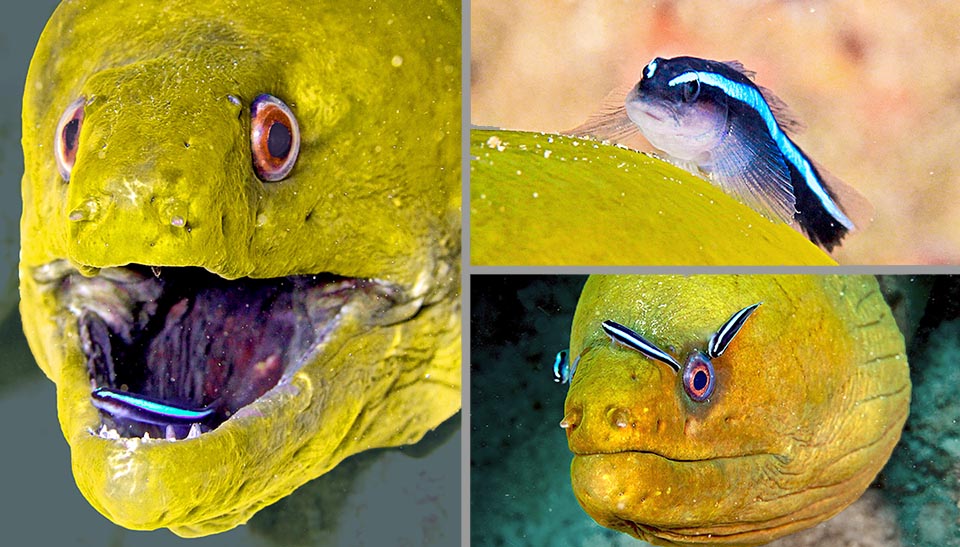
After the meal it’s good to brush the teeth and the Green moray often goes in one of the “cleaning stations” of fishes world where the big calibers get cleaned by tiny shrimps or like here by the small Neon goby (Elacatinus oceanops) who takes off also the skin parasites © Allison & Carlos Estape and © Kevin Bryant (top right)
When young, the Gymnothorax funebris is a hermaphrodite animal, but later on, under influence of environmental factors, the sexes define themselves, establishing themselves permanently.
The resilience of the species is very low with a minimal time of 14 years for the doubling of the populations and the fishing vulnerability index, very high, marking even 90 on a scale of 100. However it still appears as “Least Concern” in the 2011 IUCN Red List evaluation concerning the endangered species.
Synonyms
Lycodontis funebris Ranzani, 1839.
→ For general information about FISH please click here.
→ For general information about BONY FISH please click here
→ For general information about CARTILAGINOUS FISH please click here.
→ To appreciate the BIODIVERSITY of BONY FISH please click here.
→ To appreciate the BIODIVERSITY of CARTILAGINOUS FISH please click here.
